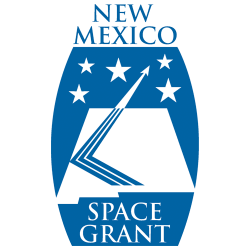
2017 SUPPORTED RESEARCH & EDUCATION
Conceptual Design and Optimization of Swarming Detachable-Tilt-Rotor-Drones for Mars Exploration
Principal Investigator: Dr. Ruey-Hung Chen and Dr. Abdessattar Abdelkefi
Affiliation/Dept.: New Mexico State University, Mechanical & Aerospace Engineering
Description: We are investigating the conceptual design of extraterrestrial detachable-drones including fixed wing unmanned air vehicle (UAV) and micro air vehicles (MAV). We are working on the (1) dynamics and stability of the tilt-rotor drone; (2) fabrication of the designed tilt-rotor micro air vehicle; (3) understanding the physics and characteristics of unmanned and micro air vehicles when performing missions on Mars; (4) investigating and enhancing the performances of the used five drones in different scenarios; and finally (5) studying the performance of various separation/connection actuation mechanisms in order to select an optimum mechanism.
Hybrid UWB/Optical Communications for Distributed Space Systems
Principal Investigator: David Mitchell
Affiliation/Dept.: New Mexico State University, Electrical & Computer Engineering
Description: Distributed space systems will play an integral role in future space missions, where multiple intelligent and affordable satellites communicate with each other to achieve a set mission goal. The proposed research focuses on novel hybrid radio/optical wireless communications circuits and systems with channel coding for low-power, spectrum-efficient, and secure wireless links, and in particular, on combining advantages from ultra-wideband impulse-radio (UWB-IR), free space optical (FSO), and low-density parity-check (LDPC) coding for studying the system design principles in the hybrid architectures. The proposed system has significant potential for inter-satellite communications of small satellite systems, which require transmission with high capacity and data rates while having challenging physical constraints as a result of their size, power, and mass.
In this project, we propose to develop a proof-of-concept hybrid UWB-IR/optical system with a novel relaying system bridging UWB-IR and optical wireless communication systems. To achieve this goal, we plan to combine the UWB transceiver with optical transceiver as well as included channel coding circuits. The theory and prototype development will be carried out by the PIs and their graduate students over the duration of one year at New Mexico State University.
Cost-Efficient Management and Development of Commercial Space Vehicles
Principal Investigator: Dr. Fernando Moreu
Affiliation/Dept.: University of New Mexico, Civil Engineering
Description: This project will identify the current research needs of software and hardware development for an autonomous network of Wireless Smart Sensors (WSS) for space missions. The proposed WSS system will evaluate the structural performance of the launch vehicle (LV) during mid-flight. This WSS Network (WSSN) will be designed to collect structural data of value for designers and managers of aerospace launching vehicles and will be utilized as a valuable asset in the development and advancement of innovative launch designs and setups.
Freshman Aerospace Design Project
Principal Investigator: Dr. Curtis O’Malley
Affiliation/Dept.: New Mexico Institute of Mining and Technology, Mechanical Engineering
Description: The course created by this grant will introduce freshman mechanical engineering students to the concepts of using modern engineering tools in a team projects environment to tackling engineering challenges though an aerospace focus design project. The students will learn to break down a complex problem into manageable subsystems and design each without forgetting to account for subsystem interactions.
Unlocking Energy from Limit Cycles for Sustainable Life-Support Systems in Lunar and Martian Environments
Principal Investigator: Dr. Nadipuram R. Prasad
Affiliation/Dept.: New Mexico State University, Electrical & Computer Engineering
Description: The ability to utilize any ambient energy source as an excitation to induce sustained relaxed oscillations called limit cycles in an electrical system is revolutionary for energy storage systems. Presently, at technology readiness level 1, we are working on a breadboard prototype with typical source excitations. TRL 1, a breadboard prototype with typical source excitations that will raise the TRL to 3.
Monitoring of Changes in The Mechanical Performance of Epoxy-Carbon Composites Due to Accumulated Damage
Principal Investigator: Dr. Igor Sevostianov
Affiliation/Dept.: New Mexico State University, Mechanical & Aerospace Engineering
Description: We obtained preliminary results on electrical conductivity of epoxy composites containing 0.5 wt % and 1.0 wt % of graphene flakes Both of these materials are electrically conductive and their conductivity decrease with the level of tensile stresses in the specimens. This property makes graphene reinforced epoxy a good candidate for self-diagnostic structural materials desired in many branches of practical applications, especially in aerospace ones.
